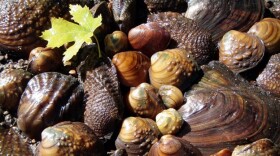The last time I spoke with you, we discussed the Japanese beetle, an exotic invasive that is eating gardens across the Northwoods. Of course, there are many more exotic invasive plants and animals in Wisconsin including the Eurasian Watermilfoil, Common Buckthorn, Garlic Mustard, the Rusty Spotted Lanternfly, and the Spiny Water Flea to name a few. However, there are many exotic plants and animals that we don’t consider to be pests. Corn is native to Mexico, soybeans are native to Asia, tulips are native to Europe. Most of our domesticated animals are exotic with domestic cattle originating in Asia. Many of these plants and animals are exotic but not extremely invasive. They have become part of ecosystem around us. One exotic animal that I had the opportunity to pursue last week is the Ring-necked Pheasant. Let’s take a look at this exotic animal and how it has become established in Wisconsin and beyond.
The Ring-necked Pheasant, an animal native to central and eastern Asia and parts of Japan, was introduced in the late 1800’s and has populated much of the northern and western United States and southern Canada. Much of the Ring-necked Pheasant's current range is the result of multiple introductions, largely because of its popularity as a game bird. Attempted introductions have taken place in nearly 50 countries, with success throughout much of Europe and North America, as well as Hawaii, New Zealand, Chile, and elsewhere.
Male Ring-necked Pheasants are beautiful birds with red faces and an iridescent green neck with a bold white ring. The male’s very long tail is coppery with thin, black bars. As with many bird species, the females are quite ordinary - brown with paler scaling on the upperparts; buff or cinnamon underparts with black spotting on the sides; and thin, black bars on their tails.
Ring-necked Pheasants are birds of agricultural areas intermixed with areas of taller vegetation, which they use for cover. You will find ring-necked pheasants on game farms in northern Wisconsin, but you will have to go south into the heart of Wisconsin’s agricultural areas to find wild breeding populations. Look for them along rural roadsides, grassy strips in contour fields, in brushy areas, or hedgerows, which provides cover beside corn, soybean, or other grain fields. They forage on the ground in fields, where they eat waste grain, other seeds, and insects when available. They will then roost in the cover near these fields. Ring-necked Pheasants usually walk or run and only occasionally resort to flying, usually when disturbed at close range by humans or other predators. Males give a loud, cackling display that can be heard over long distances.
Male pheasants are territorial giving crowing call while briefly drumming with wings. One male may have several mates, the females associating with each other in a small flock on his territory. In courtship, male struts in half-circle around female with back and tail feathers tilted toward her, near wing drooping, face wattles swollen. Nests are on the ground in dense cover. They consist of a shallow depression lined with grass, leaves, weeds and are built by the female.
Females lay eggs in clutches of 10-12 in April to June depending on region. Incubation is by female only, 23-28 days. Downy young leave nest with female shortly after hatching and mostly feed themselves. Male pheasants rarely accompany female and brood. Young are capable of short flights at about 12 days but stay with female for 10-12 weeks.
The Wisconsin Department of Natural Resources State Game Farm and the pheasant stocking program provide pheasant hunting opportunities on public and private lands and cooperate with conservation groups dedicated to promoting pheasant hunting in the state. All ring-necked pheasants provided by the DNR are produced at the State Game Farm. Approximately 300,000 eggs are incubated during the pheasant production season. Weekly hatches occur from early April through mid-July. At the end of the hatching season, approximately 230,000 chicks will be hatched. Many of these chicks will be reared on the State Game Farm, with some going to conservation clubs that participate in the Day-old Chick program. Hen chicks are also available for sale to the public.
Both the Wisconsin DNR and ring-necked pheasant conservation groups release pheasants in the fall for the Wisconsin pheasant hunting season. All hunters who want to pursue pheasants must purchase a pheasant stamp. The funds generated from your pheasant stamp purchase go directly to habitat management for the ringed-necked pheasant in Wisconsin.
Remember that not all exotic plants and animals are considered invasive. Some of these exotic animals, like the ring-necked pheasant, have become an important part of our hunting and family traditions.









